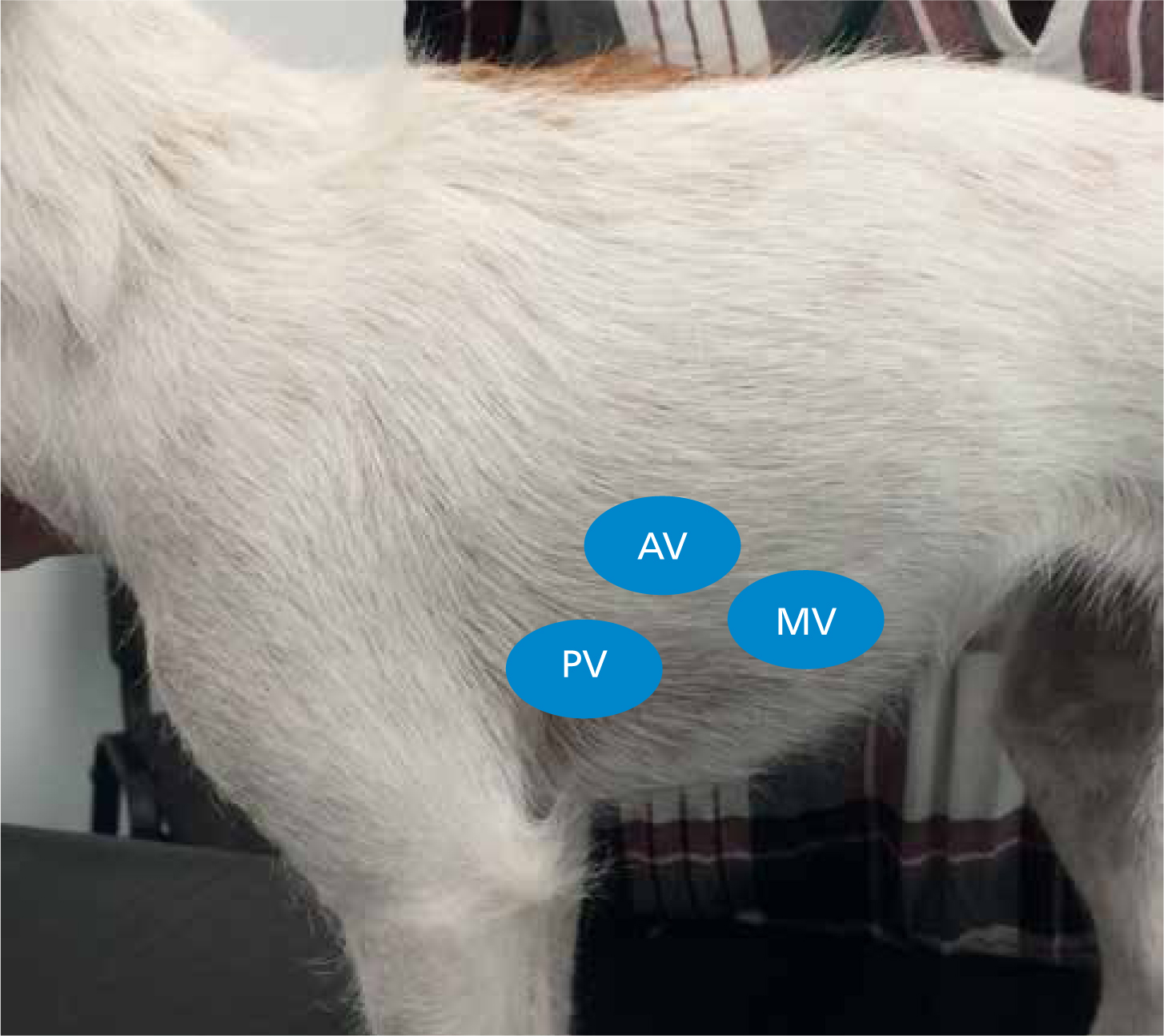Understanding the relevance of heart murmurs is an important skill in veterinary practice. Hearing additional sounds above the normal ‘lub’ and ‘dub’ sounds raises questions as to whether heart disease is present, and if it is, how severe it is. When an owner is told their pet has a heart murmur, they usually want to know the prognosis for their pet, which can be difficult to predict. Alternatively, if anaesthesia or medical treatment is required, veterinary professionals need to know the risks associated with any treatment provided. Murmurs can be indicative of heart disease severity in dogs with mitral valve disease, but not in dogs with dilated cardiomyopathy. Murmur detection in cats is also an unreliable indicator of heart disease. For an accurate guide of cardiac function, an echocardiogram is still the gold standard diagnostic tool. However, it cannot remove all risks associated with anaesthesia or aggressive fluid therapy.
There are two normal heart sounds, the ‘lub’ sound known as S1, and the ‘dub’ sound, known as S2. S1 occurs when the atrioventricular valves close, and marks the start of systole. S2 occurs when the semilunar valves close, and marks the start of diastole. Any other sounds are described as additional heart sounds. These additional sounds are described by three separate features. The first is where they are heard the loudest, called the point of maximal intensity (PMI). Figures 1 and 2 show the PMI on the left and right side of the thorax in the dog. Table 1 lists the different PMI locations in the dog and cat.


| Structure | Location |
|---|---|
| Mitral valve (left apex) | Dog—left side, 5th intercostal space at costochondral junction |
| Aortic valve (left base) | Dog—left side, 4th intercostal just above costochondral junction |
| Pulmonic valve (left base) | Dog—left side, between 2nd–4th intercostal space, just above sternum |
| Tricuspid valve (right apex) | Dog—right side, 3rd–5th intercostal space near costochondral junction |
The second feature is that additional heart sounds are described by their timing. Sounds heard between S1 and S2 occur during systole. This is the most common type of heart murmur recorded in small animal medicine (Martin and Corcoran, 2006). Sounds heard between S2 and S1 occur during diastole. Diastolic murmurs are rare in dogs and cats (Martin and Corcoran, 2006). Occasionally, sounds can occur throughout systole and diastole, and are described as continuous murmurs. The most common example of a continuous murmur is the one associated with patent ductus arteriosus.
Finally, murmurs are described by their intensity, or loudness. Table 2 describes the grading system used in small animal medicine. A precordial thrill is a vibration that can be felt through the fur and skin overlying the main area of turbulence, and occurs with loud murmurs.
| Grade | Murmur |
|---|---|
| I | Very soft murmur. Only heard in quiet surroundings after careful auscultation |
| II | Soft murmur, but easily heard |
| III | Moderate intensity murmur |
| IV | Loud murmur, without a palpable precordial thrill |
| V | Loud murmur with a palpable precordial thrill |
| VI | Very loud murmur that can be heard with the stethoscope lifted away from the chest. Precordial thrill present |
What is a heart murmur and what does it mean?
A heart murmur is an abnormal sound of a prolonged duration. Normal blood flow should pass through blood vessels with minimal turbulence, and not create any extra sound. However, if there is a vibration of sound caused by high velocity, abnormal blood flow, turbulence or reduced blood viscosity, audible turbulence can be heard. Heart murmurs can indicate heart disease, but sometimes occur when the heart is structurally normal. These are called innocent or functional murmurs, and are usually of lower intensity (less than III/VI). If there is no heart disease present, no treatment is needed. Table 3 highlights different causes of heart murmurs.
| Heart disease | Flow murmurs | Other causes |
|---|---|---|
| Leaking valves (e.g. mitral valve disease) | Innocent murmurs | Anaemia |
| Stenotic valves (e.g. pulmonic stenosis) | Physiological murmurs | Hyperthyroidism |
| Holes in the heart (e.g. ventricular septal defects) |
Mitral valve disease (MVD) is the most common acquired heart disease in small animal medicine, accounting for about 75% of cardiac disease seen in dogs in general practice (Atkins et al, 2009). Prevalence of MVD increases with age, and can be seen in 100% of high risk breeds (Mattin et al, 2015), such as the Cavalier King Charles Spaniel. It is most common in small-medium sized breed dogs. MVD is usually diagnosed early in general practice because of its characteristic left-sided systolic heart murmur. MVD can be a slow progressive disease therefore not always conveying a poor prognosis. One study showed that only 46% of dogs diagnosed with MVD died of their heart disease (López-Alvarez et al, 2015). That study looked at how physical examination, history and ancillary testing of 244 dogs could help create a clinical severity scoring system for MVD. The same study showed that a murmur intensity of grade III or above correlated to a higher risk of cardiac mortality.
Dilated cardiomyopathy (DCM) is the other main acquired heart disease seen in dogs. It can be primary in origin or secondary to dietary deficiencies or doxorubicin toxicity. DCM has been reported in Dobermanns for a long time (Calvert, 1997), but other large or giant breed dogs have also been described (Dukes-McEwan, 2010). DCM is characterised by ventricular dilatation and systolic dysfunction. This poor systolic function means that a heart murmur is often low grade in its intensity, usually less than III/VI. Therefore, in contrast to MVD, severity of the disease cannot be associated with murmur intensity, and other diagnostic methods such as echocardiography and electrocardiography are vital tools in diagnosis.
Detection of heart murmurs in cats is also unreliable to diagnose hypertrophic cardiomyopathy (HCM) (Luis Fuentes, 2015). In fact, a couple of studies have shown that cats with a heart murmur actually have a more favourable outcome. Fox et al (1995) described echocardiographic findings and survival times associated with HCM in 46 cats. Rush et al (2002) looked at survival times of 260 cats and reported that cats presenting with aortic thromboembolism had the worst prognosis, and Payne et al (2010) looked at 127 referred cats and saw that left atrial enlargement with HCM had a worse prognosis. It has been suggested that the favourable outcome in cats found to have a heart murmur is because investigations are performed on auscultation findings, rather than clinical findings. The murmur is often caused by systolic anterior motion of the mitral valve, causing a dynamic left ventricular outflow tract obstruction. A study by Wagner et al in 2010, showed that of 199 apparently healthy cats that were auscultated and had echocardiography performed, 34% had heart murmurs, and 16% of cats with no murmur had heart disease.
Most congenital heart diseases will give an audible murmur, and are usually associated with disease severity, such as aortic and pulmonic stenosis, or mitral or tricuspid valve dysplasia. Patent ductus arteriosus has a characteristic continuous heart murmur, heard throughout systole and diastole. However, a ventricular septal defect (VSD) is the general exception to the rule. VSDs are most commonly located just below the aortic valve, and paradoxically, the smaller the hole, the louder the murmur. This directly correlates to the amount of pressure across the hole, so the higher the pressure, the greater the resistance, the greater the audible sound. A larger hole means less resistance, and although usually resulting in more severe clinical signs, has a quieter murmur (Martin and Dukes-McEwan, 2010). Small defects can sometimes close spontaneously before 2 years of age.
Other heart sounds
Occasionally, other sounds can be heard. The most common of these is the gallop, so called because it can sound like a galloping horse on auscultation. A gallop occurs in diastole, is lower pitched than S1 and S2 and is either an S3 or S4 sound. Distinguishing between S3 or S4 is very difficult, so usually a gallop is all that is noted. An S3 sound occurs because of ventricular dilation and myocardial failure. It can sometimes be heard in dilated cardiomyopathy, or advanced valvular heart disease. An S4 sound is associated with atrial contraction in dogs and cats that have abnormal ventricular relaxation and stiffness. In cats, it can be heard with advanced hyperthyroidism or hypertrophic cardiomyopathy. Sometimes, it can be a transient finding in older, stressed, or anaemic cats.
Anaesthesia and heart disease
It is important to remember that all anaesthesia carries risk, but if cardiac disease is suspected, or diagnosed, the following suggestions can be incorporated into practice protocol. These points have been adapted from the American Animal Hospital Association (AAHA) Anaesthesia Guidelines for Dogs and Cats:
Adapted from AAHA Anaesthesia Guidelines (Bednarski et al, 2011).
Conclusion
Heart murmur intensity in MVD is a useful indicator for veterinary professionals. However, auscultation alone is insufficient for cats at risk of HCM and dogs at risk of DCM. Further diagnostic tests, such as using cardiac biomarkers like NT-proBNP and/or echocardiography are recommended to identify cardiac disease and assess cardiac function. This, however, is unhelpful for practices that are not equipped with cardiac specialists or advanced equipment, and need to anaesthetise their patient. Therefore, it is suggested to monitor patients at risk carefully, starting with pre-operative baselines of heart rate, rhythm and pulse quality. If under anaesthetic or on intravenous fluids, systolic blood pressure, oxygenation, and respiratory rate and effort, should be monitored regularly, and an electrocardiograph for anaesthesia or if an arrythmia is suspected.

